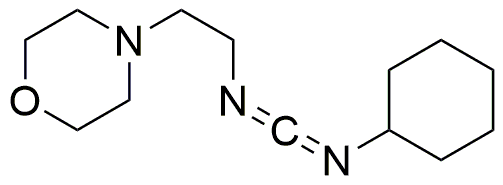1-cyclohexyl-3-(2-(4-morpholinyl)ethyl)carbodiimide is widely utilized in research focused on:
- Peptide Synthesis: This compound is a powerful coupling agent in the formation of peptide bonds, making it essential for researchers in biochemistry and molecular biology who are synthesizing peptides for various applications.
- Protein Conjugation: It facilitates the conjugation of proteins to other molecules, such as drugs or imaging agents, which is crucial in developing targeted therapies and diagnostic tools in the pharmaceutical industry.
- Bioconjugation Techniques: Its ability to activate carboxylic acids for reaction with amines makes it valuable in bioconjugation techniques, enhancing the efficiency of creating stable bioconjugates for research and therapeutic purposes.
- Drug Development: In medicinal chemistry, it is used to create novel drug candidates by linking small molecules to biologically active compounds, aiding in the discovery of new therapeutics.
- Surface Modification: This compound is employed in modifying surfaces of biomaterials, improving their biocompatibility and functionality, which is particularly beneficial in the fields of tissue engineering and regenerative medicine.
General Information
Properties
Safety and Regulations
Applications
1-cyclohexyl-3-(2-(4-morpholinyl)ethyl)carbodiimide is widely utilized in research focused on:
- Peptide Synthesis: This compound is a powerful coupling agent in the formation of peptide bonds, making it essential for researchers in biochemistry and molecular biology who are synthesizing peptides for various applications.
- Protein Conjugation: It facilitates the conjugation of proteins to other molecules, such as drugs or imaging agents, which is crucial in developing targeted therapies and diagnostic tools in the pharmaceutical industry.
- Bioconjugation Techniques: Its ability to activate carboxylic acids for reaction with amines makes it valuable in bioconjugation techniques, enhancing the efficiency of creating stable bioconjugates for research and therapeutic purposes.
- Drug Development: In medicinal chemistry, it is used to create novel drug candidates by linking small molecules to biologically active compounds, aiding in the discovery of new therapeutics.
- Surface Modification: This compound is employed in modifying surfaces of biomaterials, improving their biocompatibility and functionality, which is particularly beneficial in the fields of tissue engineering and regenerative medicine.
Documents
Safety Data Sheets (SDS)
The SDS provides comprehensive safety information on handling, storage, and disposal of the product.
Product Specification (PS)
The PS provides a comprehensive breakdown of the product’s properties, including chemical composition, physical state, purity, and storage requirements. It also details acceptable quality ranges and the product's intended applications.
Certificates of Analysis (COA)
Search for Certificates of Analysis (COA) by entering the products Lot Number. Lot and Batch Numbers can be found on a product’s label following the words ‘Lot’ or ‘Batch’.
*Catalog Number
*Lot Number
Certificates Of Origin (COO)
This COO confirms the country where the product was manufactured, and also details the materials and components used in it and whether it is derived from natural, synthetic, or other specific sources. This certificate may be required for customs, trade, and regulatory compliance.
*Catalog Number
*Lot Number
Safety Data Sheets (SDS)
The SDS provides comprehensive safety information on handling, storage, and disposal of the product.
DownloadProduct Specification (PS)
The PS provides a comprehensive breakdown of the product’s properties, including chemical composition, physical state, purity, and storage requirements. It also details acceptable quality ranges and the product's intended applications.
DownloadCertificates of Analysis (COA)
Search for Certificates of Analysis (COA) by entering the products Lot Number. Lot and Batch Numbers can be found on a product’s label following the words ‘Lot’ or ‘Batch’.
*Catalog Number
*Lot Number
Certificates Of Origin (COO)
This COO confirms the country where the product was manufactured, and also details the materials and components used in it and whether it is derived from natural, synthetic, or other specific sources. This certificate may be required for customs, trade, and regulatory compliance.

